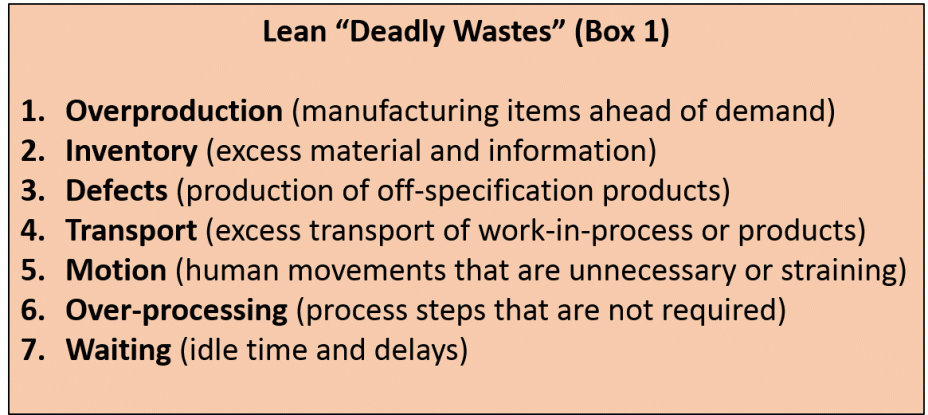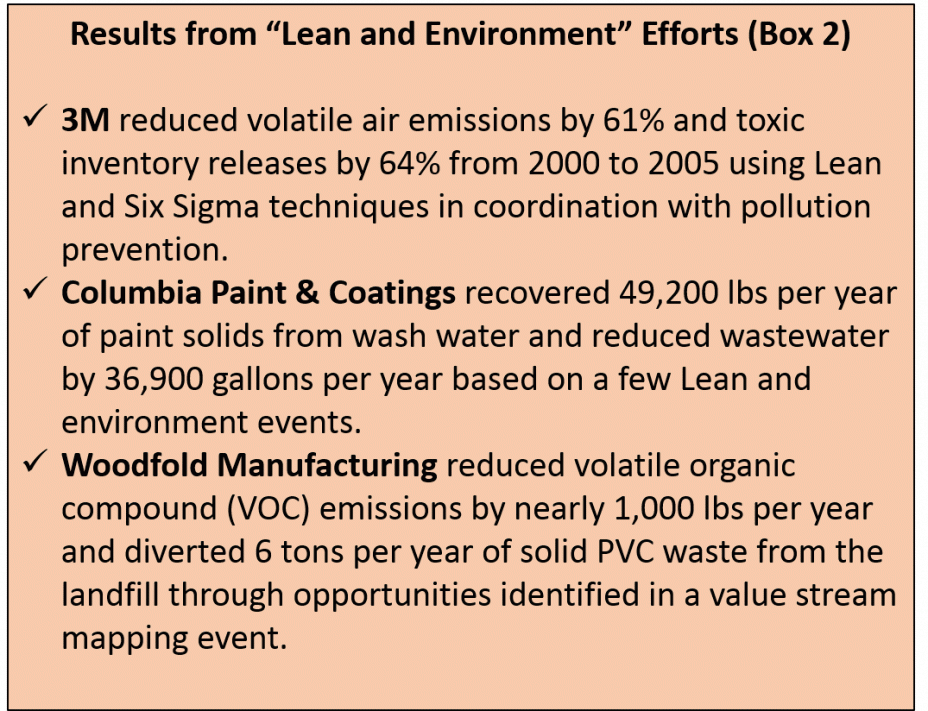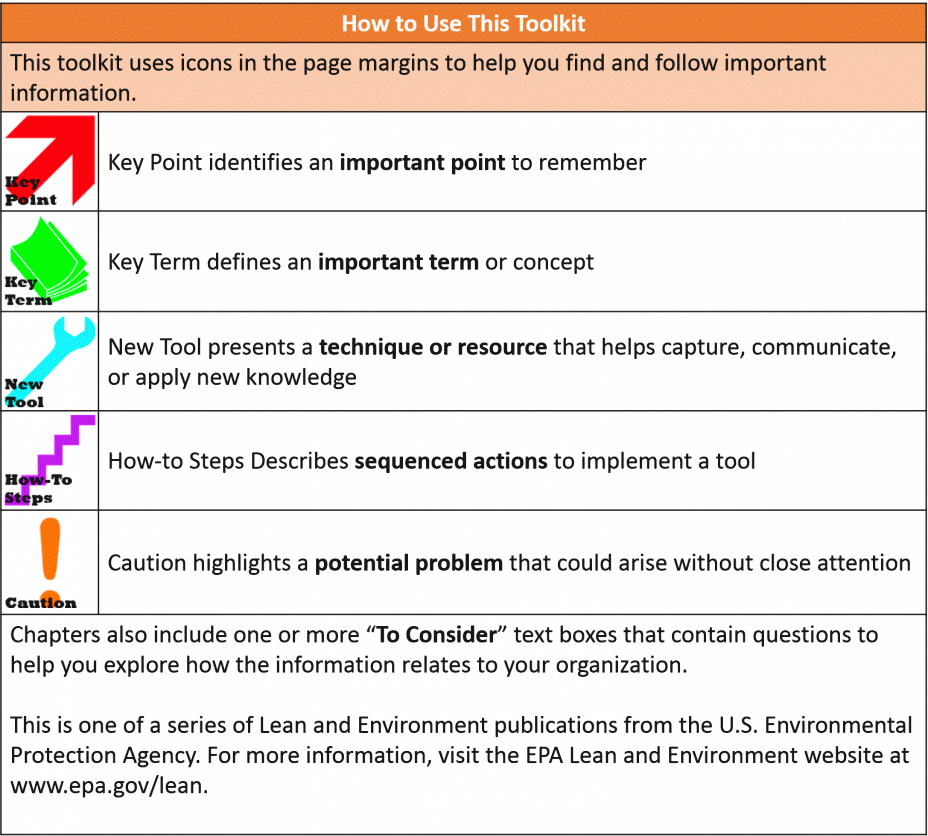Environmental Professional’s Guide to Lean and Six Sigma: Executive Summary
- Lean and Six Sigma Definitions
- Why Connect Lean, Six Sigma, and Environmental Efforts
- How Lean and Six Sigma Relate to the Environment
- Integrating Lean and Environmental Improvement Efforts
- Getting Started with Lean and Environment
- How to Use This Toolkit
- Toolkit Navigation
Lean and Six Sigma are two powerful business improvement systems that are rapidly being deployed across multiple manufacturing and service sectors. This Environmental Professional’s Guide to Lean and Six Sigma is designed to introduce environmental professionals - including environmental health and safety managers, environmental agency personnel, and non-governmental environmental technical assistance providers - to these methods. The guide describes how Lean and Six Sigma relate to the environment and provides guidance on how environmental professionals can connect with Lean and Six Sigma activities to generate better environmental and operational results.
Lean and Six Sigma Definitions
Lean: historically referred to as Lean manufacturing, refers to the principles and methods of the Toyota Production System. Lean methods focus on the systematic identification and elimination of non-value added activity (called “waste”). Box 1 introduces Lean’s “Deadly Wastes.”
 Six Sigma: developed by Motorola and popularized by General Electric, refers to a method and set of tools that utilize statistical analysis to measure and improve an organization’s performance, practices, and systems with a prime goal of identifying and eliminating variation to improve quality.
Six Sigma: developed by Motorola and popularized by General Electric, refers to a method and set of tools that utilize statistical analysis to measure and improve an organization’s performance, practices, and systems with a prime goal of identifying and eliminating variation to improve quality.
Why Connect Lean, Six Sigma, and Environmental Efforts
Lean and Six Sigma both rely on a continuous improvement culture that is very conducive to pollution prevention and sustainability. Compelling reasons for linking Lean, Six Sigma, and environmental improvement efforts include:
- Fast and Dramatic Results: Lean produces compelling results quickly. Lean events typically last 2–5 days, during which teams dramatically reduce production lead times and costs, while improving product quality and customer responsiveness. Leveraging Lean efforts to include environmental issues can yield impressive environmental results as well.
- Continual Improvement Culture: Lean and Six Sigma tools engage employees throughout an organization in identifying and eliminating production wastes. When environmental wastes are included, Lean and Six Sigma become powerful vehicles for engaging employees in identifying and implementing environmental improvement opportunities.
- Avoided Pitfalls: Integrated “Lean and environment” efforts can minimize environmental impacts and navigate regulatory and permitting issues that may arise in operational changes from Lean and Six Sigma.
- New Market for Environmental Improvement Ideas: By connecting with Lean and Six Sigma practitioners, environmental professionals can connect the wealth of environmental resources with those who are driving strategic and fundamental operational changes.
How Lean and Six Sigma Relate to the Environment
On their own, Lean and Six Sigma efforts can result in significant environmental performance gains. However, since these approaches are not environmentally driven, they can miss opportunities to achieve even better environmental results. By adding environmental wastes to Lean’s deadly wastes, organizations can harness the powerful drivers behind Lean and Six Sigma to make businesses more competitive while reducing environmental impacts and wastes (see Box 2).
While Lean and Six Sigma have many similarities with environmental initiatives, they also have important differences, including the following:
- Similarities: Lean, Six Sigma, and environmental improvement initiatives incorporate a philosophy of continual improvement, “waste” elimination, and employee engagement.
- Differences: The drivers for Lean and Six Sigma are fundamentally about competitiveness. Lean and Six Sigma practitioners also use different languages (including Japanese terms such as kaizen, kanban, and muda) and employ different tools (including value stream mapping, kaizen events, and 5S) than those used by environmental professionals.
 It is important for environmental professionals to understand how to talk to Lean and Six Sigma practitioners in a way that maximizes the likelihood of successful partnerships. Attempts to shift Lean and Six Sigma efforts away from their competitiveness drivers are likely to be less effective than efforts to integrate environmental considerations into the Lean and Six Sigma methodologies.
It is important for environmental professionals to understand how to talk to Lean and Six Sigma practitioners in a way that maximizes the likelihood of successful partnerships. Attempts to shift Lean and Six Sigma efforts away from their competitiveness drivers are likely to be less effective than efforts to integrate environmental considerations into the Lean and Six Sigma methodologies.
Integrating Lean and Environmental Improvement Efforts
There are a range of ways environmental professionals can improve results by leveraging Lean and Six Sigma efforts. “Lean and environment” approaches refer to strategies for integrating environmental considerations and tools into Lean and Six Sigma implementation. Examples of Lean and environment efforts include:
- Connect Lean, Six Sigma, and Environmental Efforts at Facilities. Environmental health and safety personnel can support operations-driven Lean and Six Sigma efforts, expanding their traditional scope, revealing hidden wastes, and improving environmental and operational results.
- Deliver Lean and Environment Technical Assistance. Environmental technical assistance providers can partner with Lean and Six Sigma service providers to jointly deliver Lean and environment services.
- Use Lean to Enhance Environmental Programs and Processes. Visual controls and other Lean concepts can improve the effectiveness of compliance-assistance efforts, and environmental agencies can use Lean to reduce waste in administrative processes such as permitting processes.
Getting Started with Lean and Environment
There’s no single “right” way to do Lean and environment, and the best way to learn is to try it out. A few steps for getting started are as follows:
- Learn about Lean. Learning about Lean and Six Sigma is a good first step for understanding how these efforts can advance environmental goals.
- Get Involved with Lean Efforts. If you work at an organization using Lean or Six Sigma, set up time to meet with Lean managers at your organization and volunteer to participate in Lean events or trainings.
- Frame “Environment” in Lean Terms. When advancing Lean and environment ideas, it’s important to speak the language of Lean and Six Sigma and explain how including environmental considerations in Lean efforts will address core business needs and priorities.
- Bring a “Problem Solving” Orientation to Lean and Six Sigma Teams. The bias of Lean toward rapid improvement may require environmental professionals to operate in different ways, focusing on identifying opportunities to reduce wastes in Lean events, thinking creatively about solutions to potential issues, and anticipating potential regulatory issues.
With the expansion of Lean and Six Sigma implementation, as well as the growing recognition of the importance of environmental issues, environmental professionals have an exciting opportunity to leverage Lean and Six Sigma to reduce wastes and significantly improve environmental outcomes.
How to Use This Toolkit

Toolkit Navigation
- Contents & Acknowledgements
- Executive Summary
- Chapter 1: Why Lean and Six Sigma Are Important to the Environment
- Chapter 2: What Is Lean?
- Chapter 3: What Is Six Sigma?
- Chapter 4: How Do Lean and Six Sigma Relate to the Environment?
- Chapter 5: Why Does It Matter How We Talk About Lean and Environment?
- Chapter 6: Lean and Environment Applications
- Chapter 7: Conclusion
- Appendix A: Lean and Six Sigma Resources
- Appendix B: Lean and Environment Resources
- Appendix C: Lean and Six Sigma Glossary
- Appendix D: Environmental Glossary
- Appendix E: Summary of the Washington Lean and Environment Pilot Projects
